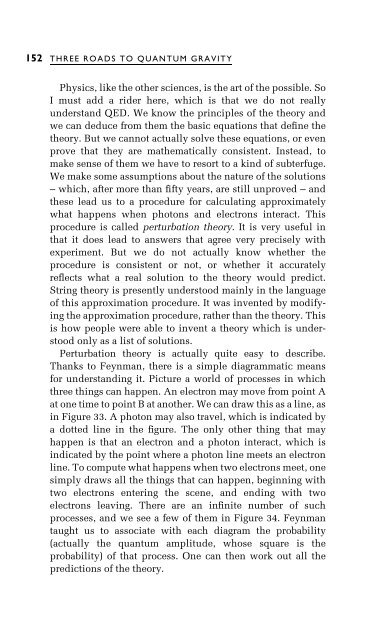Three Roads To Quantum Gravity
Three Roads To Quantum Gravity
Three Roads To Quantum Gravity
Create successful ePaper yourself
Turn your PDF publications into a flip-book with our unique Google optimized e-Paper software.
152 THREE ROADS TO QUANTUM GRAVITY<br />
Physics, like the other sciences, is the art of the possible. So<br />
I must add a rider here, which is that we do not really<br />
understand QED. We know the principles of the theory and<br />
we can deduce from them the basic equations that de®ne the<br />
theory. But we cannot actually solve these equations, or even<br />
prove that they are mathematically consistent. Instead, to<br />
make sense of them we have to resort to a kind of subterfuge.<br />
We make some assumptions about the nature of the solutions<br />
± which, after more than ®fty years, are still unproved ± and<br />
these lead us to a procedure for calculating approximately<br />
what happens when photons and electrons interact. This<br />
procedure is called perturbation theory. It is very useful in<br />
that it does lead to answers that agree very precisely with<br />
experiment. But we do not actually know whether the<br />
procedure is consistent or not, or whether it accurately<br />
re¯ects what a real solution to the theory would predict.<br />
String theory is presently understood mainly in the language<br />
of this approximation procedure. It was invented by modifying<br />
the approximation procedure, rather than the theory. This<br />
is how people were able to invent a theory which is understood<br />
only as a list of solutions.<br />
Perturbation theory is actually quite easy to describe.<br />
Thanks to Feynman, there is a simple diagrammatic means<br />
for understanding it. Picture a world of processes in which<br />
three things can happen. An electron may move from point A<br />
at one time to point B at another. We can draw this as a line, as<br />
in Figure 33. A photon may also travel, which is indicated by<br />
a dotted line in the ®gure. The only other thing that may<br />
happen is that an electron and a photon interact, which is<br />
indicated by the point where a photon line meets an electron<br />
line. <strong>To</strong> compute what happens when two electrons meet, one<br />
simply draws all the things that can happen, beginning with<br />
two electrons entering the scene, and ending with two<br />
electrons leaving. There are an in®nite number of such<br />
processes, and we see a few of them in Figure 34. Feynman<br />
taught us to associate with each diagram the probability<br />
(actually the quantum amplitude, whose square is the<br />
probability) of that process. One can then work out all the<br />
predictions of the theory.



![arXiv:1001.0993v1 [hep-ph] 6 Jan 2010](https://img.yumpu.com/51282177/1/190x245/arxiv10010993v1-hep-ph-6-jan-2010.jpg?quality=85)


![arXiv:1008.3907v2 [astro-ph.CO] 1 Nov 2011](https://img.yumpu.com/48909562/1/190x245/arxiv10083907v2-astro-phco-1-nov-2011.jpg?quality=85)








![arXiv:1002.4928v1 [gr-qc] 26 Feb 2010](https://img.yumpu.com/41209516/1/190x245/arxiv10024928v1-gr-qc-26-feb-2010.jpg?quality=85)
![arXiv:1206.2653v1 [astro-ph.CO] 12 Jun 2012](https://img.yumpu.com/39510078/1/190x245/arxiv12062653v1-astro-phco-12-jun-2012.jpg?quality=85)
